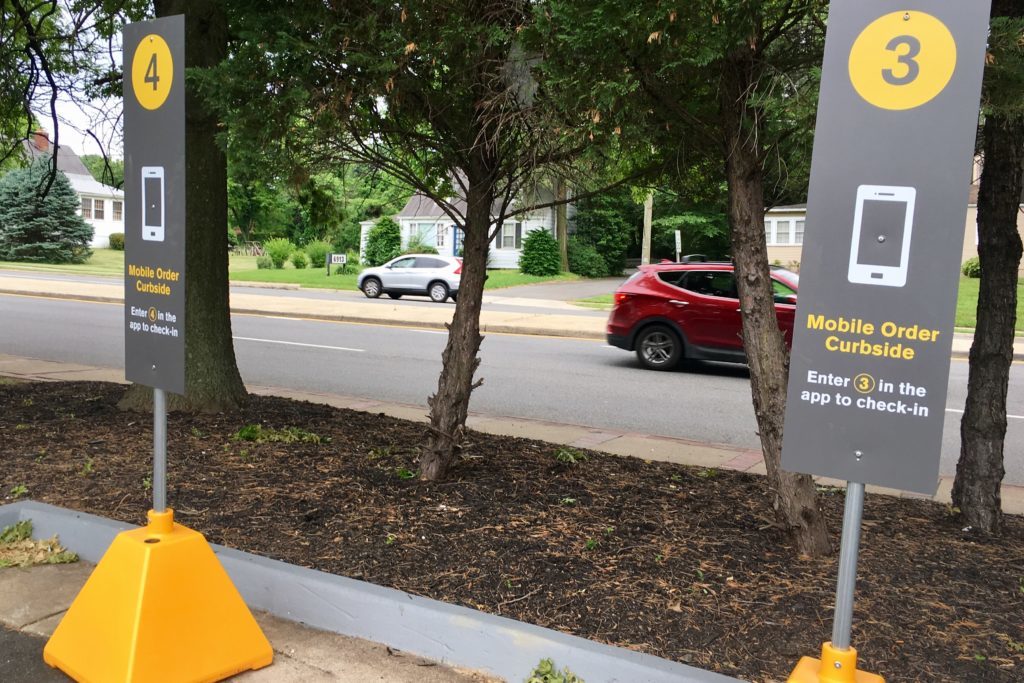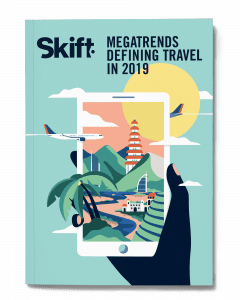Restaurant Megatrends 2019: Forget Main Street, It's the Year of the Suburb
Skift Take
As they race to dominate in the market, third party delivery companies are targeting large, suburban markets to fuel expansion. National chain partnerships boosted these efforts in 2018 and will continue to drive growth in 2019.
We've just released our annual industry trends forecast, Skift Restaurant Megatrends 2019. You can read about each of the trends on Skift Table as well as download a copy of our magazine here.
It's a work-night-Wednesday in Weehawken, New Jersey, and the hottest spot for dinner has nothing to do with white tablecloths or advance reservations. It's a walk in, sticky-fingers barbeque joint called House of 'Que, which has just fêted its grand opening and is already delivering take-out via Uber Eats.
This place is so new, Dave the bartender didn't know which delivery service his restaurant is using — but his customers do. "I order this from Uber Eats when I don't feel like leaving the apartment," says Paul, the patron next to me, as he tucks into a thick slab of smoked beef brisket. He likes the convenience and comfort of delivery, and he's not alone. In the past six months, Uber Eats delivery orders in New York City's suburbs, including New Jersey, have increased by over 50 percent.
The trend is happening on a national scale. Right now in the U.S., 63 percent of all restaurant traffic is off-premises (which includes both delivery and drive-thru sales). "It is perhaps the most important growth trend in restaurant sales," says Hudson Riehle, Senior Vice President of Research, for the National Restaurant Association. And according to Morgan Stanley estimates, food delivery will consume 40 percent of total restaurant sales, or $220 billion, by 2020.
It isn't just eaters that are driving growth. Restaurants are increasingly signing up to pay third party operators, because they can use these platforms to build an additional revenue stream and access a fleet of drivers or "dashers" as needed. In addition, restaurants can mine the aggregated consumer data that come from tech-forward delivery platforms. Would you like to know that your poke bowl sells best between the hours of 12-2pm, or that no one has ordered the stinky shrimp scampi in six months? The answer is yes, and it's called optimization.
The potential upside for companies like Uber Eats, Grubhub, DoorDash, and Postmates is huge, and they're all racing to increase market share. But first-tier cities no longer mark the finish line. To win in the long run, they have to dominate unsaturated markets, too.
Welcome to Suburbia
Expansion into the suburbs (often referenced as second-and third-tier markets) is a big part of today's third-party strategy, but each company's efforts differ in speed and scale. The top three largest players are Grubhub, Uber Eats, and DoorDash, as measured by both revenue and market share. These three companies alone will likely drive expansion through the end of next year and beyond.
To measure their growth, it is useful to separate delivery data between "urban core" and "non-urban" centers, defined as a district lying immediately outside a city or town.
In urban cores — including New York, Chicago, Los Angeles, San Francisco, Boston, Philadelphia, and Washington, D.C. — the dominant player is still GrubHub (which includes brands Seamless and Eat24). According to Earnest Research, GrubHub captured 62 percent of total urban market share in the third quarter of 2018, followed by Uber Eats and Postmates.
Outside the urban cores, things get interesting. Earnest Research shows that in the rest of the U.S. market, it's a head-to-head battle between DoorDash (31 percent market share) and Uber Eats (with 30 percent). In third place is Grubhub, coming in at 27 percent.
So, they're getting creative, and breaking into entirely new markets. Uber Eats, for example, launched in 2015 in New York, Los Angeles, and San Francisco. Today, the company serves customers in Eugene, Oregon, Burlington, Vermont, and Cedar Rapids, Iowa.
"Three years ago, this expansion wasn't even possible. We had to test our model and prove that it worked," says Ana Mahony, head of U.S. Cities for Uber Eats. It worked, by almost any measure. Today, Uber Eats reaches more than 350 markets across 36 countries. The company services approximately 200,000 restaurant partners, and raked in $2.1 billion gross bookings in the 3rd quarter alone. And all this happened, before Uber Eats announced its partnership with Starbucks, which grants it exclusive rights to deliver from a quarter of Starbucks' U.S. stores. (Get ready for lukewarm lattés!)
Competitor DoorDash is taking note. "This is very much a paradigm shift. Consumer expectations across the country are changing. They are expecting to get anything they want delivered instantaneously. It's true in small towns, and it's true in urban centers. In the last six months, growth has been fantastic from a geographic perspective. And we're just at the very beginning," DoorDash's COO, Christopher Payne tells Skift Table. DoorDash operates in more than 3,300 cities as of January 2019, has exclusive partnerships with both Wendy's and the Cheesecake Factory, and is aggressively targeting suburban markets.

Curbside delivery for mobile orders at a McDonald's in suburban Maryland.
Fast-Food Nation
The words "lucrative" and "exclusive" are music to Wall Street's ears, especially when they're used to describe partnerships with national chains.
In Uber Eats' case, its exclusives with McDonald's and Starbucks helped sparked a sky-high proposed valuation of tens of billions of dollars, ahead of its parent company's expected initial public offering in 2019. Meanwhile, rival Grubhub currently has a market cap of $6.9 billion, supported by partnerships with Taco Bell, KFC, White Castle, and Subway. These partnerships are considered game-changers because they imply proliferation, and serve as their own catalysts for expansion.
"Many suburban areas tend to have a larger number of chain restaurants than independent mom and pop restaurants, making it advantageous for Grubhub to offer takeout from these familiar chains to local residents who may not be accustomed to the idea of ordering delivery," says Katie Norris, Senior Manager of Communications at GrubHub.
All of this hinges on customers being 'accustomed' to one platform or another. It's the power of human habit, coupled with one-click-away convenience. Delivery platforms that personalize transactions by storing customer data, are — pun intended — sticky. "Once customers sign up, 80 percent never or rarely leave for another platform," according to McKinsey & Company research. That means whoever signs up the most customers in the least amount of time wins. It's a winner-takes-all dynamic for third party services, and technology has created a suburban battle field.
Uber's Policy Research Scientist Jonathan Wang echoes this trend in corporate terms: "The dominant trend is for increasing service levels down the list of cities, reaching into smaller and smaller urban areas over time." Uber Eats is so interested in rapid expansion, it is considering partnerships with municipal transit authorities and senior centers to reach untapped demand. Bear in mind, this is the same company mulling the addition of food-delivery drones to its offerings — though, that's at least a few years away from reality.
Leaving Main Street
Meanwhile, as costs of operation in cities rise, restaurants are re-thinking locations.This has often come out of necessity, with commercial property prices at record highs, according to Real Capital Analytics' National Price Index.
But not all restaurants need to be located on Main & Main to succeed, thanks to the ever-expanding reach of digital marketing and social media. And raising capital might also be within closer reach than once thought. "To mitigate high rents, many brands are opening in second-tier locations and that's very attractive to investors," says Chad Spaulding, Managing Director at the U.S.-based investment firm Capital Spring. "We spend more of our time seeking low-rent, low-investment type opportunities that provide a value to the consumer that you can count on in tougher times in the wider economy."
Suburban locations not only fit this bill, they also solve the urban issue of oversaturation. There is simply less competition the farther afield you go. And now, you can actually go further than before. Because Uber Eats drivers and DoorDash dashers can soon be there to meet you — in 30 minutes or less.
Jennifer Parker is a writer and reporter based in New York City, covering culture, travel, and the travel industry. Her work frequently appears in esteemed publications such as Bloomberg Pursuits, Saveur magazine, Watch Journal, and the Washington Post.
Download Your Copy of Skift Megatrends 2019


The travel industry's top event returns this fall.
September 16-18, 2025 - NEW YORK CITY

